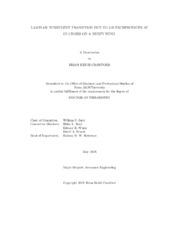| dc.description.abstract | Laminar flow has the potential to dramatically reduce fuel consumption and/or extend the range of modern aircraft. However, before laminar-flow aircraft can be made practical, the effect of surface imperfections must be better understood. Many studies have been performed on the effects of distributed roughness and other types of imperfections. Two-dimensional step excrescences, however have not been studied in significant detail until recently. Two-dimensional steps are common on real aircraft due to practical considerations such as skin-panel junctions, high-lift-device interfaces, deicing mechanisms, etc. Traditionally, these 2-D excrescences have been treated as just another form of roughness; however, the behavior of these steps is fundamentally distinct.
The present study tests the effect of 2-D excrescences near 1% chord in order to examine the effects of pressure gradient and curvature. Testing on a 30° swept-wing model is performed in both the flight environment aboard a Cessna O-2A Skymaster, as well as in the Klebanoff-Saric Wind tunnel at Texas A&M University. In both environments, IR thermography is utilized to detect the global laminar–turbulent transition location. In the wind tunnel, a hotwire traverse is also utilized to map out the boundary layer and further measure the influence of these excrescences.
Interactions between the crossflow instability and these excrescences are observed. Both critical and subcritical step induced transition behavior is present. Comparisons are made to other contemporary experiments in order to draw conclusions about the influence of pressure gradient, sweep, and curvature on the step-induced transition behavior. The resulting data are intended for use in validating an ongoing companion computational effort. | en |


